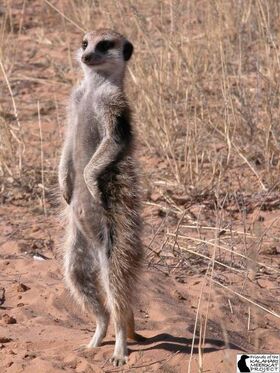|
Meerkat
| |
|
Genus
|
Suricata
|
|
Kingdom
|
Animalia
|
|
Phylum
|
Chordata
|
|
Class
|
Mammalia
|
|
Order
|
Carnivora
|
|
Family
|
Herpestidae(Mongoose family)
|
|
Species
|
Suricata suricatta
|
|
Average lifespan
|
10-15 years
|
The Meerkat (Suricata suricatta) is a small member of the mongoose family, which is part of the Feliformia ("cat-like carnivores") order. They are also refered to as suricates, slender-tailed meerkats and grey meerkats. Meerkats inhabit the deserts and scrub-lands of the sourthern African region including Botswana, Angola, Namibia and South Africa. They live in hierarchal family groups known as mobs or clans. Their complex co-operative society has made them become regarded as one of the most social mammals in the world. Wild meerkats have been known to live up to 12 years while those in captivity can live up to 15 years. However, there are reprots on one captive individual reaching 20.6 years old.
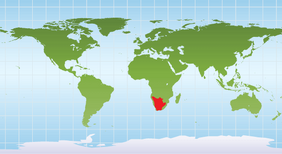
Meerkats are mainly found in South Africa.
Etymology
The genus, Suricata, was first classifed in 1776 by the German naturalist Johann Christian Daniel von Schreber. The species name, Suricatta, was not added until 1905. There is plentiful confusion over the origin of the meerkat's name. The name 'meerkat' is Afrikaans for 'mongoose'. Though unconfirmed, it's a possibility that 'meerkat' derived from the Afrikaan phrase 'meer kat as hund', meaning 'more cat than dog'. Another belief is that the name was given by misidentification on the behalf of early Dutch settlers. In Dutch the name 'meerkat' refers to the 'guenon', a species of monkey, and that the name was simply given to the wrong animal. Also, in Dutch 'kat' means cat and 'meer' means lake, and so 'meerkat' also refers to 'lake cat'. As the species are not cats nor do they occur near lakes, the word 'meerkat' is further underlined as being adapted to a misidentified animal. Another theory is that a potential Indian sailor on board a
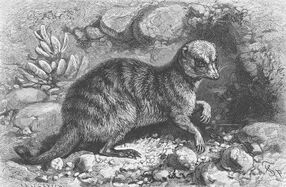
Meerkat Diagram (1893)
Dutch East India Company ship named the meerkat after the Sanskrit word for monkey, 'markata'. The origin of the meerkat's other name, 'suricate', is a little more straight-forward; 'suricate' means 'stockstaartje' or 'stokstermeerkat' which is Dutch for 'little sticktails'. The date of when the common-names were added to Suricata Suricatta is unknown. Today, the animal is most commonly refered to as meerkat, but in some countries go by their other name, suricate, 'Erdmännchen' in German (meaning 'little earth men') and 'hycryky' for the Nama people of Namaqualand in Africa.
Mythology
It is a popular belief in the Zimbabwe and Zambian regions of Africa that the meerkat is a 'sun angel'. It is said that the 'sun angels' are sent by the gods to protect villages, straying cattle, and lone tribesmen from the 'moon devil' or werewolf. The name 'sun angel' was likely applied to the meerkat due to their "glowing" appearence in the morning sunlight during their routinely sun-basks.
Anatomy
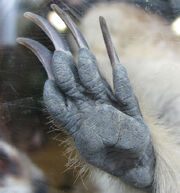
Meerkat's Foot
A meerkat is a small diurnal herpestid(mongoose). Males weigh an average of 731 grams(1.61 pounds) and females weigh 720 grams(1.58 pounds). It has a long slender body and limbs give it a body length of 25 to 35 cm(10 - 14 inches) and with a tail length of 17 - 25 cm(7 - 10 inches). Its tail is not bushy like other mongoose species but is rather long, thin and with tappers to a black tipped colored tail. Meerkats use their tails for balance when standing upright. Its face tappers coming to a point at the nose which is brown. Their snouts point out to a length of 5-8 centimeter(2-3 inches) and are whiskered. In fact, no two meerkats have the same whiskers pattern. Their eyes have
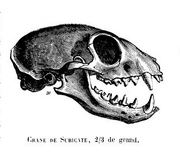
Meerkat Skull
black patches around them which helps to deflect the glare of the sun. They have binocular vision, a large peripheral range and depth precipitation. Meerkats have small black crescent-shaped ears that can close when digging to keep sand out. At the end of each of a meerkat's fingers are non-rectractable claws used for digging holes for prey and in combat and self-defense. Claws are used at the muscular hind-legs to help climb the occasional tree. They have four toes on each foot and long, slender limbs. Meerkats have a total of 36 teeth, which is 2-4 less than the rest of the mongoose species. Their coat is fawn in color with short parallel stripes across their backs, extending from the base of the tail to the shoulders. Like with their whiskers, every meerkat has its own unique stripe pattern. The underside of the body has no markings but the belly has a patch of which is only sparsley with hair and shows black skin underneath. Meerkats use this area of their body to absorb the sun's heat when standing on their rear legs, usually early in the mornings after cold desert nights.
Diet and Foraging Behavior
Meerkats are primarily insectivores preying on on a variety of insects. Their diet consists of:
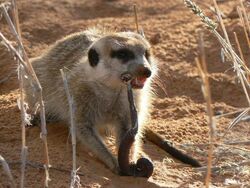
Feeding on a Millipede
- Lizards
- Scorpions
- Snakes
- Spiders
- Plants
- Eggs
- Millepedes
- Centipedes
- Burrowing skinks
- Small birds
- Rodents
- Ants
- Larvae
- Grubs
- Beetles (of all varieties)
Meerkats have also been seen eating more unusual prey such as turtles and baby ground squirrels. They are immune the strong venom of scorpions, but only have some resistant to snake venom. Unlike humans, they have no excess body fat stores and therefore foraging for food is a daily activity. Meerkats forage in a mob with one individual on sentry duty, keeping watch for predators while the rest of the group hunts for food. Sentry duty is approximately 1 hour long and is usually done by males. The individual on sentry duty gives a peeping sound called the Watchman's Song, it reassures the other meerkats that there is someone on lookout. Pups do not start to independently forage for their own food until about 1 month old and do so by watching an older member in the group who acts as a Pup tutor.
Predators
Meerkats have many predators which is why they live in mobs, for security purposes. Birds of prey are the biggest threat and cause the meerkats to dive into one of over a thousand "bolt holes" in their territory. Terrestrial predators such as jackals, snakes and foxes are often confronted. Snakes in particular are always attacked by meerkat gangs to prevent a far more dangerous encounter below ground. Some of the meerkat's natural predators include:
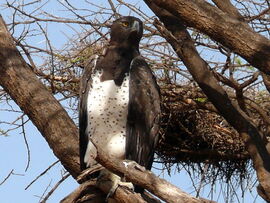
Martial eagle, number one meerkat predator
- Martial eagles (their most-feared enemy)
- Goshawks
- Black-backed jackals
- Genet cats (only to meerkat pups)
- Giant eagle owls
- Cape Cobras
- Puff Adders
- Yellow Mongooses (only to meerkat pups on rare occasions)
- Mole Snakes
- Cape Foxes (only to meerkat pups)
- Bateleur Eagles
- Black-breasted Snake Eagles
- Desert Lions (very rarely, but has been observed)
Social Structure
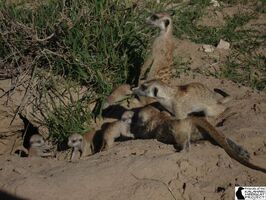
Meerkat Babysitting Burrow
Meerkats are co-operative breeding animals and have a complex social system. They live in Mobs of 5-50 individuals consisting of a Alpha pair and their offspring which remain in their natal group until adulthood. When the leaders' offspring reach maturity, they take their place as subordinates and assist in raising younger litters. Breeding couples remain together for years, even for life. The dominants monopolise breeding rights viciously and will attack and banish lower-ranking meerkats (their matured offspring) to prevent their status from being challenged. The survival of pups largely depends on the seasons, the abundance of food, and the availability of helpers to help rear their pups.
Mob
Other linked article: Mob

Meerkat Mob
Meerkats live a life which is 80% based on team work. By living in a mob they not only provide each other with an early warning system in case of predators, but also other life structures depend on group living. Meerkats live in mobs which can vary in terms of size depending on food availability and resources within their territory. A single mob can have 5-50 members. Normally males who are in their 1st or 2nd year of life contribute to sentry duty more often but females can also frequently contribute, in fact, all members except the dominant female will usually contribute at sentry duty at regular occasions. living in a mob also helps with co-operative breeding by providing the alpha pair with helpers to rear pups. As the pups grow they will need to learn how to forage and living in a mob provides the pups with suitable tutors who will not only guard them but also teach them how to hunt for different prey items. The size of a mob affects the size of a territory range. There are more than one mobs living near each other as a result of overlapping territory ranges. Mobs do often encounter violent clashes with each other and the size of the mob affects their defense against intruders and chances of driving away rival mobs. Large mobs have a higher success rate in holding on to large territories and driving off intruders than small mobs. Within a mob there is a social structure governed by the alpha pair(the dominant female and male). The dominant meerkats assert their position by chin swiping, anal marking,hip slamming and violent attacks on subordinates, this prevents any chances of insubordination among the subordinate meerkats. Once female subordinates reach 3 years old they are usually already evicted by the dominant female(commonly her mother,sister,aunt etc), and this removes the chances when the subordinate might challenge the dominant female for her position. Males leave their natal(birth) mob voluntarily after 1 year old and go on what we call Roving expeditions to other mobs in search of any mating opportunities. Sometimes subordinate males are chased out of the group by the dominant male(commonly his father,brother,uncle etc) who has a sole purpose of holding on to his position.
Splinter Groups and Subgroups
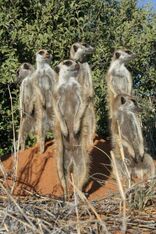
Meerkat Group
When a mob gets too large they tend to commonly split. Instances of group splits occur when during foraging trips when some members move further away in the search for food and split from the main mob and only realize that they have splintered from the main family later on. Normally the splinter groups can reunite with the main mob at the sleeping burrow or at further foraging exertions. Sometimes the two sub groups see each other and begin to war dance after intrepreating each other as rival mobs intruding on their territory, but without too much blood shed they catch the scent of each other. Since meerkats identify each other more by scent rather than sight they will recognize the common scent among them and reunite as one family again. Sometimes the two or even 3 splinter mobs do not reunite and become sub mobs of the main family mob and after a short while establish themselves as new mobs headed by a new alpha pair and inhabit a new territory range.
Foundation of New Mobs
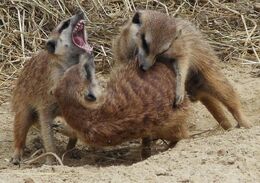
Contending for Dominance
New mobs are formed commonly as a result of evicted female meerkats combining with roving males from other groups. Some mobs are started by a mix-gender splinter group from the main mob who establish a new territory range but most instances of new mob being founded occur when subordinate female meerkats get evicted from their birth mobs. Unlike males, female meerkats stay within their birth mobs for life and do not voluntarily leave it unless they are evicted by the dominant female. Dominant females commonly evict subordinates commonly their daughters, nieces or sisters to prevent any challenge for the dominant position. If evicted females do not manage to rejoin their family then they disperse and with luck, are joined by unrelated males either wild or from other mobs and form a new mob and family.
Alpha Pair
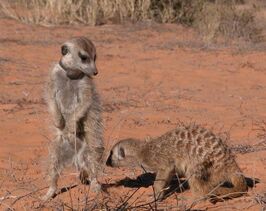
Alpha Meerkats
Within a mob there is an alpha pair consisting of two dominant individuals, refereed to as the dominant female and the dominant male. They are the breeding pair in the mob. The dominant female is the leader of the mob with the dominant male at her side and breeding partner. The alpha animals are noticeably the largest and most powerfully sized members in the mob. The dominant male is the resident breeding male in the mob who controls access to the dominant female, contributes to sentry duty occasionally and contributes to the defense of the mob and their territory. The dominant female is the Queen of the group who is the resident breeding female as well as the leader of the group, because according to the KMP a mob cannot be established until there is a dominant female. She is the matriarch of her family and monopolies breeding in the mob by producing pups and so as to maintain the size of the mob and also controls the breeding success of the subordinate females commonly her daughters. The dominant female and dominant male will assert their position by hip slamming, anal marking, chin swiping and sometimes launching vicious attacks on subordinates. The dominant female will mostly dominate the subordinate females in case of any insubordination among the subordinate females and the dominant male will concentrate on the subordinate males in case of any subordination among the subordinate males. Both genders will drive out subordinates to maintain control of their alpha positions and ensure that their pups survive and that system of pup survival is involved around the capability of control by the dominant female. Dominant females will commonly kill any pups born to subordinates and in doing so not only entire that her pups survive but also by killing the subordinate pups, the subordinate mother will still be able to lactate and act as wet nurse for the dominant females' pups. Both dominant genders will hold on to their position depending on their capability to control but normally the Dominant female will hold on to her position longer than the dominant male since meerkats live in a matriarchal society. When the dominant female comes into oeustrus, the dominant male will stay close to her in what is called Mate guarding to prevent her from mating with other males and therefore ensures that he fathers her pups.
Dominant female

Dominant female meerkats
The dominant female is a female meerkat with a dominant status and main breeding female in the mob. The Dominant female is commonly the largest and oldest female in the mob. She is usually the leader of the mob and commonly mother to most of its members. Dominant females have a superior position in the mob above all individuals including the dominant male. As the main leader of the mob she controls the mob regarding the movement of the mob and which foraging places they take each day. She is the only female in the group to successfully breed and maintains this rule in the most vigorous and violent way than any other animal species. The dominant female attacks the subordinate females and this not only helps her hold on to her top position but also controls the breeding success of the subordinate females in the mob. Its a fact that meerkats live in a Matriarchal society where the dominant female has full control and power of the group. She is even sometimes dominant to the dominant male and this is because the male needs acceptance from the dominant female to be her breeding partner, and for this reason dominant males are commonly seen grooming the dominant female. The dominant female's pups the ones mostly likely to survive with the help of her daughters. The dominant female will evict subordinates to maintain control of her position and safe guard the survival of her pups. Once a dominant female dies she is usually replaced by her daughter or sometimes she is overthrown and one of the subordinates takes over. If she is overthrown then she will most probably be evicted by the new dominant female.
Dominant male
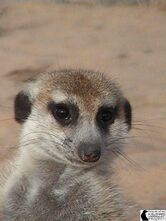
Dominant male meerkats
The dominant male is a male meerkat who has a dominant status and superior position over all subordinate males in the mob. He is the breeding partner of the dominant female and she often has higher control over him. The dominant male is commonly the largest male in the mob who contributes to the defense of the mob and territory range. He keeps roving males out of the group and mate guards the dominant female from time to time especially during her oeustrus period. He sets dominant displays over the subordinate males in the mob and sometimes drives them out, though male evictions are rare among meerkats. If the dominant female dies then the dominant male will either stay in the mob for only a short while or leave it because he cannot breed with his daughter who claimed dominance after the first dominant female. If roving males immigrate into the mob then they do commonly chase out the resident dominant male or if the dominant male dies then subordinate male takes over though he will not able to breed with the dominant female if she is related to him.
Reproduction
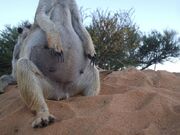
Pregnant Meerkat
Meerkats reach sexual maturity at 1 year old and can have litters from 1-7 pups, with 4 being the most common size. Meerkats can produce 4 litters in 1 year, depending on the availability of food. A female may have as many as 70 pups in her lifetime. Meerkats are iteroparaus and can reproduce any time throughout the year though pup season occurs during the rainy season when food is most abundant. Pregnancy is identifiable after approximately 4 weeks following copulation. After a gestation period of 70 days, meerkats give birth underground in a burrow and pups only emerge from the burrow at around 3 weeks old. Newborn pups are commonly killed by other pregnant female meerkats who kill each
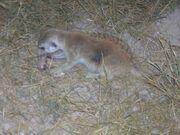
Infanticide
others' litters to ensure survival of their own unborn pups. Its normally the dominant female's pups that survive. Meerkats rarely give birth above ground due to the presence of many predators. Pup's ears open after 15 days and their eyes open at 10 to 14 days. They are weaned at 43 to 63 days. Once they surface above ground at around 3 weeks old they are cared for by the babysitters until they are old enough to go foraging with the mob at around 4-5 weeks old. While at the burrow they are suckled by the subordinate females through a process called Aloe-lactation which the subordinate females are able to produce milk for the dominant females' pups. Pups reach adulthood at 1 year old and can begin to reproduce though this is restricted as long as they stay in the mob ruled by their parents who are usually the dominant female and male.
Pups
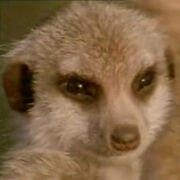
Meerkat at 3-4 Weeks
A pup is a young meerkat under 6 months old. They are born in litters
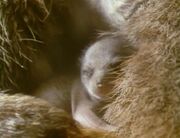
Newborn pup
ranging from 1-7 pups. They remain underground in the burrow until the age of 2-3 weeks old. Pups are babysat by helpers at the burrow until they are old enough at around 4-5 weeks old to go foraging with the adults. Pups born in the mob are mothered by the dominant female and fathered by the dominant male, though occasionally subordinates also breed and pups from as many as 5 different mothers are reared together in mixed litters of up to 13 pups. Once they reach around 4 weeks old they go on foraging trips with the whole group for the very first time and are fed by foraging members by calling out frequently in what is called Pup beging calls which encourage the foraging adults to deliver food to them. As the pups grow up and get older the adults teach them how to handle live prey like dangerous scorpion(by teaching the pups that they should first bite of the poisonous sting) and showing them how to find different prey items. Once the pups are older their begging calls become less effective and the adults ignore their calls and in doing so teach the young meerkats that they have to learn how to catch prey for themselves in order to survive. Pups learn everything from their helpers, they learn how to forage by watching the adults and while still at the burrow they watch the reactions of the babysitters to certain threats.
Playfighting
Young meerkats start to play fight from as early as 3 weeks old. Like all young animals, meerkats play-fight in order to strengthen muscles, practice fighting skills needed for later on in life and build strong b
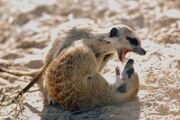
Juveniles Playfighting
onds with each other. By play fighting young meerkats learn how to relate to one another and their surroundings. Since meerkats live in mobs, the whole extended family will commonly the juvenile's rough and tumble and helps to maintain their strong family bond. As young meerkats mature their play fights will become less and focus their attention on contributing to the welfare of the mob like sentry duty and tutoring younger members in the mob. Adult meerkats also play fight and this just shows what cohesive and socially tight-knit meerkats are.
Grooming
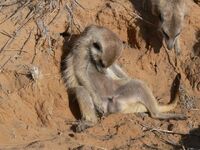
Grooming meerkat
Meerkats groom themselves in order to keep their coats free from parasites and also build and maintain strong bonds within the group. Meerkats generally groom one another after returning from a day of foraging or before mating. It is also, sometimes, a form of submission. Lower-ranking meerkats will "creep" up to dominants and groom their chest or neck in an attempt to prevent isolation from the group or a beating. A positive response often means the dominant animal will groom back.
Territorial Behavior
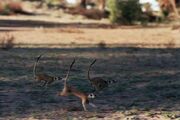
War Dancing
Mobs defend their territory from other neighbouring mobs. Intruders can either be rival mobs, newley formed mobs looking for a territory or small bands of roving males that either temporarily or permanently leave their natal mobs looking for females from other mobs. Territory size is about 1-3 km squared (though territory range depends on the size of the mob). Meerkats maintain their territory through latrine sites, visual threat displays such as war dancing to intimidate the rival mob or if all else failes, violent battles which are vicious group encounteres in which some meerkats are either killed in the fight or others sccumb to their wounds.
Maturity and Despersal
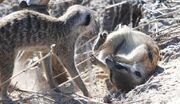
New Group Establishing Heirarchy
Meerkats reach adulthood at 1 year old. Males volunteerily leave their birth mobs alone or in roving bands either emmigrating into another mob by ousting the resident dominant male or forming new mobs with evicted unrelated females. Female meerkats never permanently immigrate into other mobs but are evicted from their mobs by the dominant female in later stages of pregnancy. Older pregnant subordinate females are most likely to be the first evicted by the dominant. Dominant females evict older subordinates to safeguard the survival of their pups and maintain their position. Although most cases are the evicted females returning to the mob after the dominant female gives birth, some may permanently desperse and start new mobs with unrelated roving males. On rare occaasions, evicted females will band together and oust resident females from smaller mobs Also, more aggressive dominant males have been witnessed evicting subordinate males on rare occasions. Therefore the conclusion is that; female meerkats never volunteerily leave a mob unlike males who will volunteerily leave a mob to search for mating opportunities.
Communication and Sounds
Meerkats constantly communicate with each other in 3 different ways: Scent, Sound and Body language. They have about 20 - 30 different sounds that have been recorded with different meanings. These calls can be broken down to 6 different categories:
Lost calls - Used by pups who have been seperated by the group
Alarm calls - Emitted by meerkats on sentry duty to warn others of danger
Lead calls - Commonly used by the dominant meerkats in deciding the movement of the group
Begging calls - Used by pups (and sometimes sneaky juveniles) to recieve prey from adults
Guard calls ("Watchman's song") - Murmuring noises by meerkats on sentry duty to reassure other members that there is someone keeping watch for danger
Contact calls - Constant calls used by foraging meerkats to keep in contact.
When meerkats forage they are constantly communicating in what sounds like growls. It helps them to keep track of one anothers' location since they sometimes forage 15 feet(5 meters apart). When pups learn how to forage they make loud calls which can be heard up to one hundred yards away. If they become separated from the adults the volume of their calls increases so that an adult can come to get them. They are many other sounds which meerkats emit. For example, subordinates will "chatter" to dominants when they feel threatened (common for females on the verge of eviction). It has recently been discovered that each meerkat has its own distinctive "voice". Members of a group can identify each other by the way they sound, much like humans can. Meerkats are the first and possibly only non-primate to have this ability.
Meerkat Sub-species
So far, there have been a total of four separate meerkat sub-species recognized, although one of these is extinct. It is believed a fifth sub-species may exist. Sub-species can be identified by variations in colour, build and location.
Confirmed Sub-Species
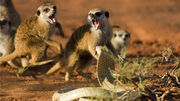
S. s. siricatta in the Kalahari
Suricata suricatta suricatta - Currently all meerkats
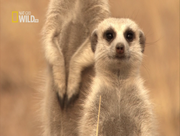
S. s. majoriae in Namibia
found in Botswana, parts of South Africa and the eastern areas of Namibia are treated as being this sub-species. Coat colour varies depending on their exact location, it ranges from brown to orange.
Suricata suricatta majoriae - This sub-species have a sturdy build in comparison to other kinds of meerkats. Majoriae occupies western areas of Namibia, where the landscape ranges from high dunes to rocky flat-lands. They are seldom seen in captivity.
Suricata suricatta iona - This sub-species occurs in a very limited area in southwestern Angola, predominantly in the Iona National Park (hence their name). Iona are the least-known of the 3 confirmed sub-species.
Suricata suricatta major - the meerkat's ancestor, once found in the Cape of Good Hope. Major was incredibly similar to the meerkat's relative, the Banded Mongoose. It was larger than modern meerkat species and had signficiantly different dentition. Major no longer exists as it has evolved into today's meerkat sub-species.
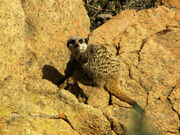
S. s. suricatta in Namaqualand
Suricata Suricatta ??? - the unconfirmed subspecies, currently it's treated as being the same as Suricata suricatta suricatta. These meerkats are said to be dark brown or grey in colour and have constrasting orange tails.They are found in southern parts of South Africa and along the coasts. Many captive meerkats appear to be this alleged sub-species.
Meerkat Conservation

Meerkat Magic Project
Over the years there have been several researches studying and conserving meerkats from various areas of souther Africa. Only two are still active today. The most recognized project is the Kalahari Meerkat Project, home to Meerkat Manor, which studies the behaviour of meerkats in the Kalahari Desert. The other project is the Meerkat Magic Conservation Project, which focuses on a sturdier meerkat species of a more southernly region. There are also many rescue and rehabilitation centres (mainly in southern Africa) that take in injured or ex-pet meerkats. The most famous of these meerkat rescues is the Fellow Earthlings Wildlife Centre in the US.
